You are here:
-
Home
›
-
Culture in South Africa
›
-
The People of South Africa
›
-
The Khoisan people
The Khoisan People,
descendants of the Khoi and San people in South Africa
The Khoisan people are descendants of the ancient
hunter-gathering San (bushmen) people, who were the earliest known original inhabitants of South
Africa followed later by the pastoral Khoi (Hottentot) people, thousands of years ago.
They are thought to have emerged out of the same gene pools as all the black people, but to have
developed on their own.
At present the san people (bushmen) are confronted by extinction with a remaining population of
100,000 people, most of them living in the north west of South Africa, Botswana and Namibia.
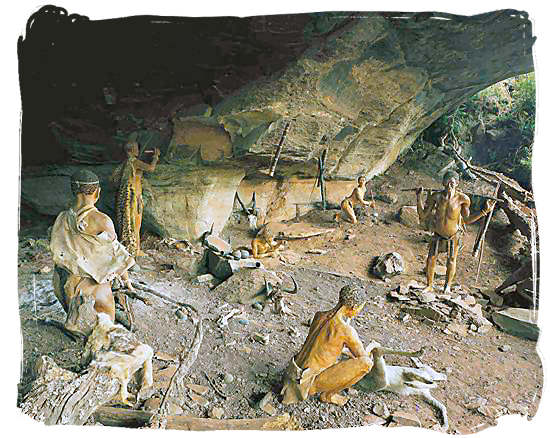
Museum scene of ancient "San" people using the Battle Cave in the beautiful Drakensberg mountains as their shelter
The Khoisan People, Blend of the Khoi and San people in South Africa
copyright © South African tourism
The San People were typical hunter-gatherers, leading a nomadic lifestyle, moving along from location to
location simply following their food source. They depended on hunting game comprising a variety of antelope
species, together with gathering wild plant foodstuffs for their survival.
The San have frequently been referred to with names such as "Bushmen", "San" or "Sonqua", "Soaqua", "Sarwa" or
"Basarwa", and "Twa", all of them basically meaning, "those without domestic livestock".
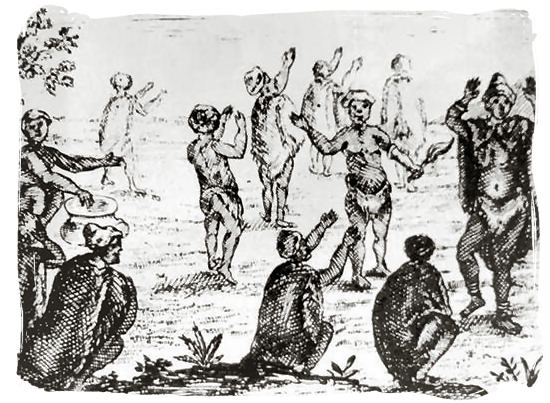
An 18th century drawing of Khoikhoi worshipping the moon
The Khoisan People, Blend of the Khoi and San people in South Africa
copyright © South African tourism
The San have a distinctive yellowish tinged complexion and because of the average length of an adult of
somewhere around 1.5 m, they are significantly shorter then members of the Black colored people. It is
commonly believed that their roots are to be found along the north coast of the African continent.
They were driven further and further south ward by expanding more powerful nations in their quest for living
space. The Black people were primarily located throughout the tropical and equatorial parts of Africa by the
time the San reached the southern regions of Africa.
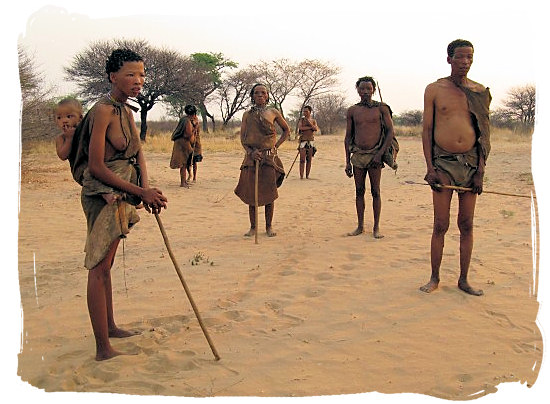
a small clan of "San" people looking and living the way their ancestors did thousands of years ago.
The Khoi and San people in South Africa
The tough and resilient little San people who were capable of producing the type of courage and compassion
needed for their survival for such a long period of time, left us a way to glimpse into their world. They
left us a fantastic heritage of rock art in the form of beautiful engravings and paintings all over the
country.
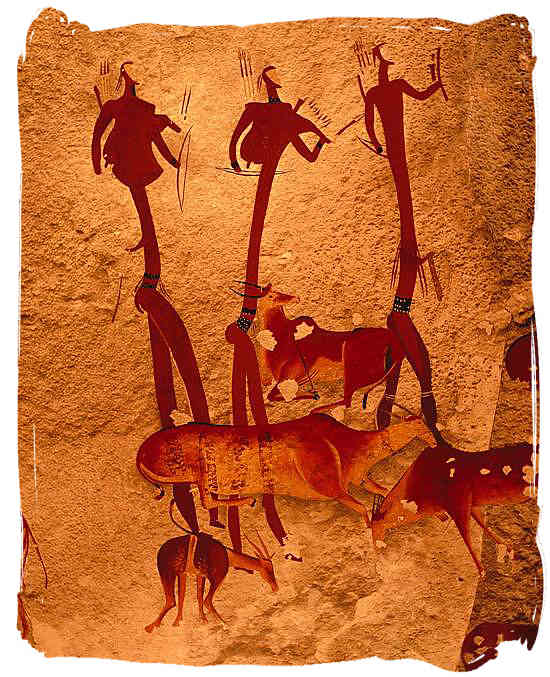
The San people have left us an invaluable legacy of marvellous animated paintings on rocks and on cave walls.
The Khoi and San people in South Africa
copyright © South African tourism
The Khoikhoi on the other hand practiced a pastoralist way of life, (a nomadic lifestyle centered around the
herding of livestock) some 2 000 years in the past and adapted their cultural lives accordingly. Just like
the San, the Khoikhoi also possessed a yellowish tinged complexion but they were larger in size.
This could certainly have been caused by the actual fact that their staple diet was protein. Their entire
existence revolved around their livestock and so they were continuously on the move in their quest of better
grazing for their cattle and sheep.
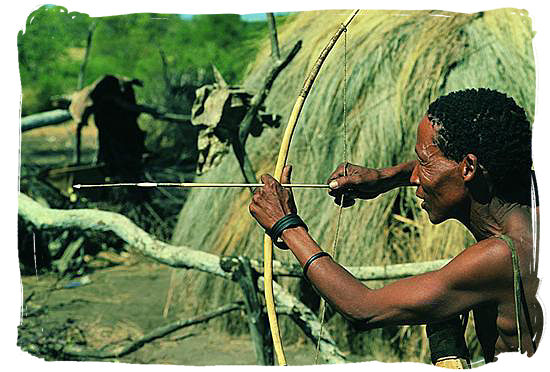
The San people hunted with wooden bow and arrow and used clubs and spears if necessary.
The Khoisan People, Blend of the Khoi and San people in South Africa
copyright © South African tourism
The hunter-gatherer San ranged widely over the area; the pastoral Khoikhoi lived in those comparatively
well-watered areas, chiefly along the southern and western coastal strips, where adequate grazing was to be
found.
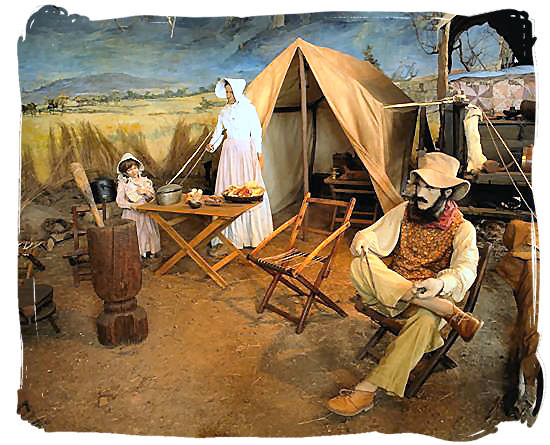
Settler family settling down on their new land.
The Khoisan People, Blend of the Khoi and San people in South Africa
copyright © South African tourism
It had been the latter which the early European settlers first came across when setting foot on South African
soil, primarily to the disadvantage of the Khoikhoi. In today's times the Khoikhoi people have become extinct
as an identifiable nation.
This happened primarily because of diseases as a consequence of assimilation with the settlers and with the
slaves in particular. Next to that there has additionally been a degree of forthright extermination.
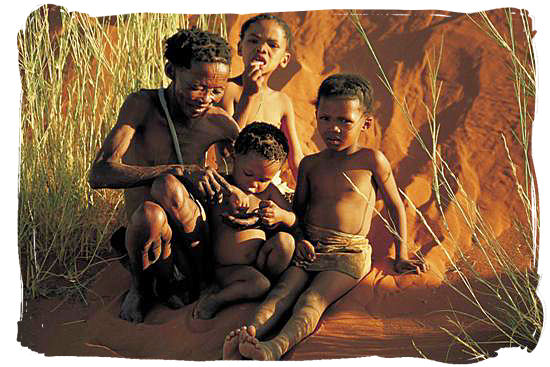
San family in the Namib desert in Botswana.
The Khoisan People, The Khoi and San people in South Africa
copyright © South African tourism
There are researchers who claim that the Khoikhoi originally moved from the great lakes in Africa to Southern
Africa long after the San. Several other researchers, on the other hand, are of the opinion that the Khoikhoi
herdsmen evolved out of the hunter-gatherer tribes in Southern Africa.
A number of languages spoken by the San happen to be substantially similar to some specific Khoikhoi dialects.
Based upon certain San and Khoi language studies, a considerable number of linguists are quite positive about
the possibility that the Khoikhoi language could well have evolved out of a San language. Another reason for the
similarities between the two peoples was the process of intermarriage between them.
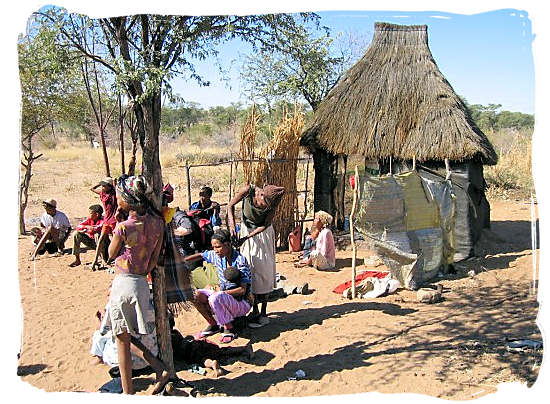
Present-day Khoisan people in a small village
The Khoisan People, Blend of the Khoi and San people in South Africa
Today we cannot speak of distinctly identifiable San and Khoikhoi people anymore. Through time they have mixed
and as a result the use of a combination of the words "Khoi" and "San" into "Khoisan" has become popular.
Deep in the Kalahari desert of South Africa, Namibia and Botswana, there is a small population of about 100 000
San or people left, trying to make a living the way their ancient predecessors did. Threatened by extinction, this
has become more and more difficult for them and these days a large number of have turned to either agriculture or
stockbreeding in order to survive.
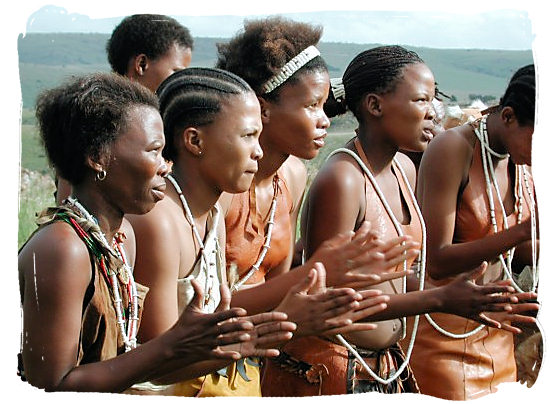
Group of modern-day female Khoisan dancers
The Khoisan People, Blend of the Khoi and San people in South Africa
Photograph by Steve McN
Top of Page
-
Home
›
-
Culture in South Africa
›
-
The People of South Africa
›
-
The Khoisan people

